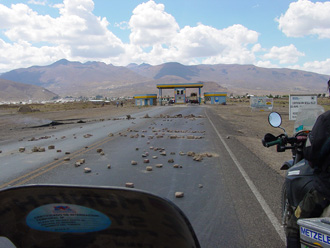Bloqueos, Bribes and BSAs
There were rocks littering the road as we approached one of the toll stations and a large crowd was gathered around a truck on the other side.
A bloqueo or roadblock!
Oururo behind us, we took the long way round to Sucre, as we had been told the more direct route was much tougher, 300kms of hard dirt. As we approached the small town of Challapata however, we began to think that maybe the direct route would have been faster. There were rocks littering the road as we approached one of the toll stations and a large crowd was gathered around a truck on the other side.
A bloqueo or roadblock!
Rocks on the road to stop the traffic
We parked up some distance away and watched for awhile. A lorry pulled up behind us and the driver came over for a chat. He didnt know what the cause of the bloqueo was either. He said that we could probably pass if we were quick, either going around the side of the toll station, or going off the road onto one of the sandy tracks that led around the town. We could see the local cars doing just that, ferrying locals from one side of the bloqueo to the other, the long way around.
We decided to chance it and went for the short option, anything to avoid battling with sand! What we didnt see was the trench that the campesinos had dug, obviously to prevent bus drivers and silly tourists from trying to get through. Luckily it must have been coca breaktime before they had finished, as the trench was only 20cms or so deep. Still was a bit of a shock as we flew over it, accompanied by the whistles from the crowd.
We had to ride some dirt, but only 60kms or so, most of it right next to the new tarmac road, not quite ready to be opened. Looked ready to me, but there was no way to sneak onto it, mores the pity.
Another toll station marks the end of the dirt
The rain clouds were following us as we left Potosi, maybe thats why we were going a little faster than usual and got caught in the only speed trap we have seen in Bolivia. The radar gun showed 93kph not very accurate, we were going at least 100!! The two uniforms were very polite, asking if we realised we were going a little fast, saying the fine was 50 bolivianos per bike (around 5) and that we would have to go back to the station with them to fill out the paperwork. We asked if it was possible to pay on the spot. Normally yes, they said, but they didnt have any receipts left how convenient. The on the spot fine was only 30 bolis, we didnt have change of course and so produced U$6. They were happy with that and so off we went, a little slower of course.
Arriving in Sucre before the rain
Back in Sucre, at Nikkis workshop, we had lots to do, got things repaired, cleaned and checked all the necessary. Met lots of interesting people there, got invited to see a chocolate factory and were told of a guy in Cochabamba who deals in old bikes and cars. That got Arno's attention and we had to then decide if we wanted to backtrack and visit him. Meantime, Marco and Cornel arrived, Africa Twin riders from Switzerland, who we had first bumped into, in La Paz. They were on their way to the Salar, so gave them our map and amongst other things told them where they could buy dynamite in Potosi.
Swiss riders Marco and Cornel leaving Sucre
Arno, was by now in old-timer fever and after a few phone-calls to Cochabamba he couldnt wait to leave!
Not to keen on riding the same bad road twice, we left the bikes in Sucre and took the bus. Yes we finally got to see the inside of a bus station. A night bus was the only option, saved us some time but it wasnt exactly very restful and we didnt get to see anything. What is the point of travelling if you never see any of the countryside?
Once in Cochabamba, we met up with Mike and were taken to see some of the bikes that have been collected from around the area. For once communication was no problem, we spoke German; his parents were German and he had worked in Germany for 8 years or so.
We were taken to one workshop where 3 or 4 guys were busy welding bike frames together inside, while outside stood at least 30 bikes, in differing states of decay. Some of the big names were there, Moto Guzzi, Triumph, Harley, BSA, Indian, even an Ural with sidecar, but no BMWs. There were a couple of cars too, waiting for the restorers touch.
Objects of Arnos affection
Back at his home, Mike showed us his treasures; an NSU Fox and an Indian from the twenties, both complete and running. He also had a couple of Indians in a crate, waiting for someone to put them back together again. Who would have thought there would be so many bikes like this in the poorest country in South America?
Mike with his Indian
Back in Sucre after another night on the bus, we picked up our bikes and headed back to Potosi, careful to stick to the speed limit this time. The town of Tupiza was next, as we rode south towards the Argentine border, the dirt road not half as bad as we had expected.






